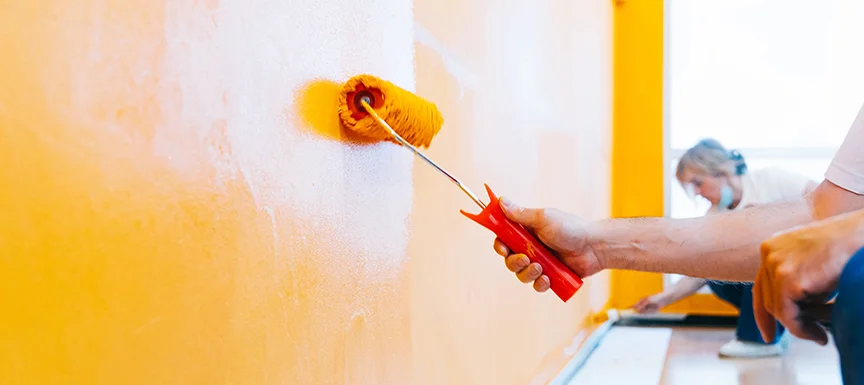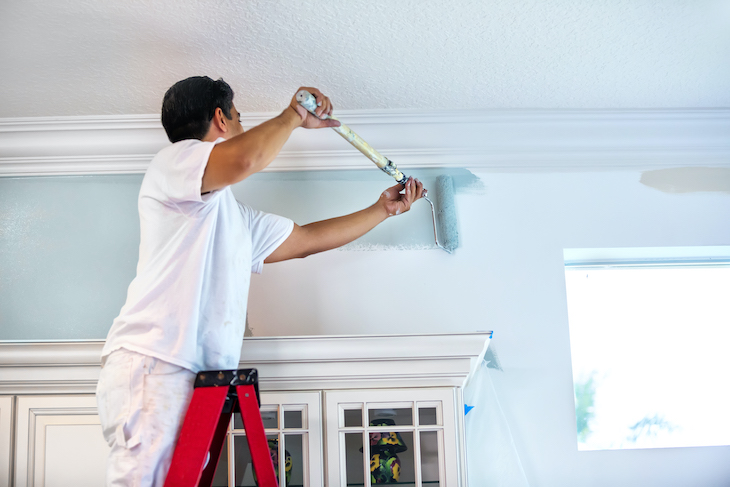The Top Perks of Shopping Local at a paint store corpus christi tx for Your next Project
Checking Out the Different Sorts Of Paint: An Overview for every single Task
Exploring the numerous kinds of paint is necessary for achieving the wanted outcome in any job. From water-based choices that offer comfort to oil-based paints understood for their sturdiness, each choice has its advantages. Specialty paints can include unique structures or coatings, while eco-friendly choices cater to those looking for sustainability. Comprehending these differences can significantly influence the success of a paint venture. What variables should one think about when making the appropriate option?
Comprehending Paint Types: Oil-Based vs. water-based
Paint types can markedly influence a task's result, and understanding the differences in between water-based and oil-based paints is essential for notified decision-making. Water-based paints, commonly referred to as latex paints, are composed of water as the key solvent. They completely dry swiftly, release fewer unpredictable organic substances (VOCs), and are easy to tidy up with soap and water. This makes them a popular selection for interior applications and settings where air top quality is a concern.
In comparison, oil-based paints utilize natural solvents, giving a long lasting, glossy surface ideal for surfaces revealed to damage, such as trim and cupboards. They take longer to completely dry, require mineral spirits for cleaning, and have a more powerful odor. corpus christi tx paint shop. Picking in between these 2 kinds depends upon the certain demands of the task, thinking about variables such as desired coating, application environment, and ease of upkeep. Each type has unique advantages and constraints, leading the option process
The Finish Issues: Selecting Between Matte, Satin, and Gloss
When choosing a paint coating, the option between matte and shiny options greatly affects both looks and capability. Matte finishes supply a subtle, non-reflective look that can conceal surface area imperfections, while shiny coatings supply toughness and ease of cleaning. Comprehending the benefits and factors to consider of each can help in making an educated decision for any type of painting job.
Matte Complete Advantages
Numerous property owners discuss the values of different surfaces, matte paint supplies unique benefits that make it a popular choice for both interior and exterior applications. Among the main benefits of matte coating is its ability to conceal surface area flaws, creating a smoother look on walls. This top quality is especially beneficial in older homes or spaces with irregular surfaces. Furthermore, matte paint takes in light instead than mirroring it, which can improve the visual of a room by offering a much more low-key and advanced appearance. Matte surfaces are usually easier to touch up than glossier options, as they can mix much more flawlessly when used over existing paint. On the whole, matte paint is an exceptional option for those seeking an improved and elegant surface.
Shiny Complete Considerations
A shiny surface can significantly change the perception of an area, providing a smooth and reflective high quality that improves both color vibrancy and light within an area. This coating is often preferred for high-traffic areas and surfaces like bathroom and kitchens, where durability and ease of cleaning are vital. Its reflective nature can highlight blemishes on walls, making proper surface area prep work essential. Glossy paints additionally often tend to show spots and fingerprints quicker, requiring normal upkeep. Furthermore, lighting plays a significant function; in brilliant settings, a shiny coating might create glare, affecting the total visual. Careful factor to consider of the details application and setting is essential when choosing a shiny coating for any type of task.
Specialty Paints: When to Use Distinctive or Chalk Paint
Specialty paints, such as distinctive and chalk paint, offer special aesthetic and useful benefits that can enhance various surfaces. Distinctive paint is suitable for producing deepness and dimension on walls, hiding imperfections while including a three-dimensional feel. It is particularly helpful in high-traffic areas where durability and aesthetic interest are essential.

Both kinds of specialty paints can transform spaces, yet picking the ideal one depends upon the preferred result and surface area demands. Textured paint may match bigger areas, while chalk paint can revitalize smaller sized items, showcasing creativity and individual design in any project.
Exterior Paints: Securing Your Surface Areas From the Aspects
Outdoor paints are vital for protecting surface areas against numerous weather. Comprehending their weather resistance features, correct surface area prep work requirements, and efficient application strategies can substantially improve resilience and performance. This section will certainly outline vital considerations for choose and making use of outdoor paints efficiently.
Climate Resistance Includes
Weather condition resistance is an important feature of exterior paints, as it figures out exactly how well surface areas can hold up against the harsh components of nature. Top notch outside paints are created to withstand damages from UV rays, moisture, and temperature level variations. UV resistance assurances shades continue to be lively in time, stopping fading and staining. Moisture resistance secures against mold and mildew and mildew, which can endanger the honesty of surfaces. Additionally, paints with outstanding temperature level resistance can acquire and expand without fracturing, maintaining their safety qualities. When selecting outdoor paints, it is essential to think about these weather resistance functions, as they add to the long life and durability of painted surfaces, ensuring they stay visually pleasing and functional despite direct exposure to the components.
Surface Area Preparation Requirements
Proper surface area preparation is an essential action in accomplishing the most effective outcomes with outside paints. To guarantee perfect bond and sturdiness, surfaces need to be extensively cleaned, getting rid of oil, mildew, and dust. This can be achieved making use of a stress washer or a scrub brush with an appropriate cleansing remedy. When cleansed, surface areas must be inspected for any kind of peeling or flaking paint, which have to be scraped look at this now away to develop a smooth structure. Fixing any type of openings or fractures is also crucial, as these can enable dampness infiltration. Additionally, fining sand rough areas advertises much better paint attachment. Finally, using a primer matched for outdoor use can enhance the paint's performance, assuring a durable coating that stands up to the elements. Appropriate preparation is key to a successful exterior paint task.
Application Strategies Tips
While using outside paints, it is necessary to use efficient strategies that ensure surfaces are well-protected versus the aspects. Choose the appropriate day for paint; reduced moisture and mild temperature levels boost attachment and drying out. Prepping the surface area thoroughly-- cleaning, sanding, and priming-- makes sure much better paint attachment and toughness. Making use of premium brushes or rollers can provide a smoother surface, while spray painting may cover huge locations effectively. Applying paint in slim, even layers protects against drips and runs. It is advisable to adhere to maker guidelines relating to drying out times between layers. Confirm appropriate air flow during application to facilitate drying out and decrease exposure to fumes. These methods greatly improve the longevity and effectiveness of outdoor paint.
Eco-Friendly Options: Low-VOC and Zero-VOC Paints
As customers become progressively knowledgeable about the ecological effect of their choices, low-VOC and zero-VOC paints have arised as preferred options. These paints are developed to contain fewer unpredictable organic substances (VOCs), which are chemicals that can vaporize into the air and add to air contamination and illness. Low-VOC paints generally include a restricted quantity of VOCs, while zero-VOC paints have negligible degrees, making them safer for both outdoor and indoor use.
The advantages of using low-VOC and zero-VOC paints prolong beyond environmental considerations; they also improve indoor air quality, minimizing the risk of respiratory system problems and allergies. Numerous makers now offer a selection of shades and finishes in environmentally friendly alternatives, making it simpler for customers to find appropriate products for their jobs. By choosing for these paints, people can add to a healthier atmosphere while still achieving the aesthetic they desire in their rooms.
Devices and Strategies for a Remarkable Application
Achieving a remarkable paint application requires the right tools and methods, which can significantly enhance the outcome. Choosing the proper brush or roller is vital; brushes function well for edges and complex areas, while rollers cover larger surfaces efficiently. Utilizing top quality products ensures better paint circulation and reduces streaks. For ideal results, surface area prep work is imperative. This consists of cleaning, fining sand, and priming surface areas to promote adhesion.
Method likewise plays a significant role. The "W" technique with a roller helps to evenly disperse paint, while long, smooth strokes with a brush avoid visible lines. Working in sections permits better control and mixing. In addition, using thin layers is preferable to thick layers, click here for info reducing the risk of drips and irregular structures. Keeping a damp edge during application aids accomplish seamless modifications between areas. By combining these devices and methods, one can accomplish a expert and sleek coating.
Tips for Maintaining and Caring for Your Painted Surfaces
Correct maintenance and care of coloured surfaces can significantly expand their life expectancy and preserve their look. Regular cleaning is crucial; using a soft fabric or sponge with light soap and water can remove dirt and dirt without harming the paint. It is advisable to prevent unpleasant cleansers or rubbing pads, as these can scrape the surface. Additionally, using a fresh layer of paint every couple of years can invigorate the color and safeguard versus wear.
For outside surfaces, inspecting for signs of peeling off or fading regularly is very important. Without delay resolving any type of issues protects against more damages. In locations vulnerable to moisture, such as washrooms, utilizing mold-resistant paint and guaranteeing proper air flow can help keep the honesty of the paint. Ultimately, making use of protective coatings can shield versus UV rays and spots, ensuring that repainted surfaces continue to be vibrant and enticing for many years to come, eventually enhancing the general visual of the area.
Often Asked Concerns
Can I Mix Different Kind Of Paint Together?
Blending various kinds of paint is typically look here not recommended, as it can lead to issues like inadequate attachment, inconsistent texture, or unexpected chemical responses. It's finest to utilize compatible paints for ideal outcomes and longevity.

Exactly how Do I Appropriately Shop Leftover Paint?
To properly keep remaining paint, secure the container tightly, label it with the date and shade, and keep it in a trendy, completely dry area far from straight sunshine and severe temperatures for ideal conservation.
What Is the very best Way to Take Care Of Extra Paint?
The most effective means to dispose of extra paint is to inspect neighborhood policies, as several areas have marked contaminated materials centers. Alternatively, think about giving away useful paint to community companies or colleges for their tasks.
How Can I Tell if Paint Is Still Excellent to Make Use Of?
To determine if paint is still excellent, analyze its shade, consistency, and smell. If it shows up separated, has an unpleasant smell, or reveals considerable changes in texture, it's most likely no longer usable.
Exist Age Restrictions for Getting Paint Products?
In lots of regions, there are no details age limitations for buying paint products. Some shops may call for clients to be at least 18 years old, specifically for products having solvents or harmful products.
Paint types can considerably influence a job's end result, and understanding the distinctions between oil-based and water-based paints is vital for educated decision-making. Water-based paints, typically referred to as latex paints, are made up of water as the primary solvent. In comparison, oil-based paints utilize natural solvents, offering a sturdy, glossy surface perfect for surface areas exposed to tear and put on, such as trim and cabinets. Specialized paints, such as distinctive and chalk paint, offer one-of-a-kind aesthetic and functional advantages that can enhance different surface areas. In locations prone to wetness, such as washrooms, making use of mold-resistant paint and guaranteeing proper ventilation can aid keep the integrity of the paint.